|
|
|||
|
(Back to Preceding Week; on to Next Week) |
|
BROAD-BILLED HUMMINGBIRD:
FIRST SOUTH CAROLINA BANDING RECORD
This week, shortly before we were to depart Hilton Pond Center for a meeting on Kiawah Island on South Carolina's coast, we got an interesting e-mail message from Annabeth Proctor who lives not far from there on Wadmalaw Island, just southwest of Charleston (see green arrow on map above). Annabeth said she had several Ruby-throated Hummingbirds coming to feeders this winter--a phenomenon increasingly common in southern U.S. coastal areas, and even inland. But Annabeth's real reason for writing was that her husband Donald had been standing close to a feeder that day when he realized one of their hummers was obviously NOT a ruby-throat; its vocalization was different, it was darker, and had a metallic blue throat instead of a red one. Familiar with our vagrant hummingbird banding work, Annabeth e-mailed us to ask if the bird might be a Cuban Emerald but reconsidered when we told her that particular species was non-migratory and had never been recorded in the continental U.S.
Although our Kiawah meeting wasn't until the afternoon of Sunday, 6 January 2008, we laid plans to be at the Proctor home that day by 6:30 a.m. In our experience it's more effective to catch winter vagrant hummingbirds at first light; they've been fasting all night and often make their first feeder runs just at dawn. To facilitate a quick departure from Hilton Pond, we loaded banding gear and a portable trap into our van on Saturday evening and set the alarm for 3 a.m. Excited by the day's potential, we were already up and moving when the buzzer went off and had the van rolling down a dark and deserted highway by 3:15 a.m.
All text, maps & photos © Hilton Pond Center Three-and-a-half hours and 220 miles later we arrived just prior to sunrise at the little town of Rockville on Wadmalaw Island, were warmly greeted by the Proctors, and immediately went to the feeder the apparent Broad-billed Hummingbird had taken over as his own. We took down the feeder--which was beside the door of a second-floor porch--placed it in our portable trap, hung the whole contraption back on the same hook, and retreated to ground level at 7 a.m. to await the hummer's arrival. Although skies were heavily overcast and it was still too dark to see any hummingbirds, Annabeth detected the broad-billed's early morning vocalization--which she described as "like a Ruby-throated Hummingbird with a frog in its throat." As dawn started to overrun darkness at the Proctor homestead, we began to hear Ruby-throats chittering and scolding from nearby shrubs and trees--probably because we had taken down ALL Annabeth's several feeders to steer the Broad-billed Hummingbird toward its favorite feeder . . . and our trap. At 7:05 a.m. we thought we saw a dark hummer swoop past the feeder, and at 7:10 a.m. could see the bird for sure as it began investigating the trap. The hummingbird made several return trips as we watched from the ground below, finally entering the trap at 7:21 a.m. We quickly flipped our remote control lever and watched as the trapdoor slid shut, securely enclosing the object of our visit.
As we climbed the stairs toward the trap, Annabeth and Donald returned a few feeders to their respective hooks; there was no sense depriving those ruby-throats of their breakfast while we worked with a more exotic species. When we reached the landing where the trap hung there was no doubt we had snared a Broad-billed Hummingbird. Even in dim morning light its fully iridescent body glistened blue and green, and its red and black bill almost glowed. This was a pretty exciting time for us, in that we'd just captured the first broad-billed we'd ever even seen.
We removed the hummer from the trap and placed it in a soft cloth bag for transport, re-hung the trap and feeder, and descended the stairs with our prize. Donald escorted us to a cottage on the property and we set up shop inside where light was better and we had a table on which to process the hummingbird. Donald even brought in an electric heater to warm our hands and some work lights to improve visibility.
When we removed the hummer from the bag all three of us admired its dazzling iridescence and the remarkable colors of its bill. There was no question this was an adult male Broad-billed Hummingbird, Cynanthus latirostris. Females of the species are drab and except for a reddish lower mandible look a lot like female ruby-throats. The only hummer with which our in-hand bird might be confused is its congener, the adult male White-eared Hummingbird, C. leucotis. The latter has a similarly colored body and bill but typically sports a prominent diagonal white stripe behind its eye; in addition, the white-eared male's head is purplish. Both species have bright white undertail coverts--visible in the broad-billed photo above--but in the white-eared the white usually extends as a central line up the abdomen.
Another way to differentiate Broad-billed Hummingbirds from closely related white-eareds is to look at the tail. When the Proctor's broad-billed first approached the feeder, even in silhouette we could see its tail was heavily notched; the tail in white-eareds is square. In the hand, the top of the broad-billed's tail was dull green while the undersides of the rectrices were metallic gun metal blue (above). It's quite interesting the tail's ventral surface--the part that would show when a courting male is facing a female--is more colorful than the dorsal side.
All text, maps & photos © Hilton Pond Center While the Proctors were marveling at their Broad-billed Hummingbird's external attributes, we placed his bill into the port on a sugar water feeder Annabeth had brought in for that purpose. The hummer drank readily--a good sign he wasn't traumatized by the capture experience. We fed him several times during the banding process, so he certainly wasn't going hungry. And by they way, if you've ever wondered why this species is called "broad-billed," take a gander at our close-up photo of the base of its top mandible (above); it is indeed significantly broader than that of a ruby-throat.
After the first hand-feeding we slipped the hummer into a paper tube that kept the him from struggling and allowed us to place him on a small electronic scale for weighing. Since the broad-billed was roughly the size of a ruby-throat, we anticipated it would weigh about the same; such was the case, with the Broad-billed Hummingbird tipping the scale at 3.37g. We took several other measurements (see table below) and were quite surprised by the bird's wing chord--the distance from the bird's wrist (bend of the wing) to the tip of its longest primary feather. After completing our measurements, we showed Annabeth and Donald Proctor how we make a hummingbird band, cutting it from a sheet of thin, flat aluminum and then forming it into a tiny ring. Using special pliers we gently placed band #Y14597 on the Broad-billed Hummingbird's left leg (photo above right)--the only way to permanently mark a hummer for studies of migration, site fidelity, and longevity. At that point the Proctor's bird became the first Broad-billed Hummingbird ever banded in South Carolina, the first one photographed here, only the second one documented for the state, and the first winter record. South Carolina's only other broad-billed occurred back in the summer of 1985; that bird was observed and reported by David and Julia Wise in the extreme northwest Mountain Province of the state. An account (slightly edited) from American Birds (1986) reads: "Although it could not be documented by photograph or by expert birders, an adult male Broad-billed Hummingbird at a Seneca SC feeder 30 July 1985 was impeccably described and compared with noticeably smaller Ruby-throateds to rule out all other species. This was, of course, a first for the Southern Atlantic Coast Region if not for the entire Atlantic Coast."
Broad-billed Hummingbirds are indeed rare in the U.S.--especially as far east as the Carolinas. (North Carolina's first broad-billed appeared near New Bern in the fall of 2001, and another was at Kill Devil Hills in mid-summer 2005.) The species breeds in extreme southeastern Arizona and throughout northern and central Mexico. The Arizona population migrates south, but it is believed Mexican broad-billeds are primarily year-round residents that would not be expected to show up at northerly locations. (See map above, on which yellow is the breeding range and green dots represent extralimital reports.) Nonetheless, there are now Broad-billed Hummingbird records for at least 19 states as far away as Oregon and Idaho or Michigan and Wisconsin. There are even reports of broad-bills from Ontario and New Brunswick--a far piece for a "non-migratory" hummingbird. What causes these birds to stray from their "traditional" breeding and wintering grounds is anybody's guess. Based on careful examination, we suspect the Wadmalaw broad-billed was a second-year male that hatched out sometime in 2007. We came to this conclusion especially because of the extent of black on the bill, brown edging on much of the body plumage, and the pale gray tips on the central tail feathers. After ageing, sexing, measuring, and banding the Proctor's Broad-billed Hummingbird, we took him outside to attempt photographing the hummer in the overcast, post-dawn light. Try as we might, we fear the poor lighting didn't allow us to do justice to this out-of-range winter hummer's plumage. Just the same, our mental image of this amazing Wadmalaw Island hummingbird will be with us for a long time. It was a privilege to journey from Hilton Pond Center to visit with Annabeth and Donald Proctor at their Rockville home, to capture and band South Carolina's second Broad-billed Hummingbird, and to help Annabeth release her hummer safely back into the wild less than an hour after we captured it. Vital Statistics for
All text, maps & photos © Hilton Pond Center POSTSCRIPT #1: In a follow-up e-mail after our trip to the Proctor's Wadmalaw Island home, Annabeth wrote: "About three hours following his release, the little Broad-billed Hummingbird reestablished his territory and returned to his normal behavior. It is amazing how quickly the other hummingbirds tried to take over his feeders." We asked Annabeth and Donald Proctor if it would be acceptable for birders to visit their Rockville home on Wadmalaw Island. Upon seeing the hummer return to and defend his territory, they replied in the affirmative but would like for folks to call before coming. If you are interested in viewing this bird, please respect their wishes. Send an e-mail to RESEARCH at Hilton Pond Center for contact information. POSTSCRIPT #2: An unexpected follow-up on the Proctor’s bird at Rockville SC came in early August 2008 when a Broad-billed Hummingbird first appeared at a feeder at the New Bern home of Patti Holland in coastal North Carolina, on the Neuse River about 300 miles due northeast of Rockville. The bird was recaptured on 9 November by Susan Holland and confirmed to be the individual we banded at the Proctors’ ten months previously. This was the third state record for the species in North Carolina. The bird was present at New Bern at least until late December 2008. One can only speculate whether this Broad-billed Hummingbird spent the months between February and July in the Carolinas or whether it returned to its typical breeding grounds in Mexico and then made another trip to the Southeast. POSTSCRIPT #3: See Vagrant and Winter Hummingbird Banding for complete list of wandering hummers we've banded at Hilton Pond Center and elsewhere.
Comments or questions about this week's installment?
Thanks to the following fine folks for recent gifts in support of Hilton Pond Center for Piedmont Natural History and/or Operation RubyThroat: The Hummingbird Project. Your tax-deductible contributions allow us to continue writing, photographing, and sharing "This Week at Hilton Pond." (Please see Support if you'd like to make a gift of your own.)
IMPORTANT NOTE: If you ever shop on-line, you may be interested in becoming a member of iGive, through which nearly 700 on-line stores from Barnes & Noble to Lands' End will donate a percentage of your purchase price in support of Hilton Pond Center and Operation RubyThroat. For every new member who signs up and makes an on-line purchase iGive will donate an ADDITIONAL $5 to the Center. Please sign up by going to the iGive Web site; as of this week, 117 members have signed up to help Hilton Pond Center. It's a painless, important way for YOU to support our work in conservation, education, and research. "This Week at Hilton Pond" is written & photographed You may wish to consult our Index of all nature topics covered since February 2000. You can also use our on-line Hilton Pond Search Engine at the bottom of this page. For a free, non-fattening, on-line subscription to |
|
Make direct donations on-line through
Network for Good: |
|
|
LIKE TO SHOP ON-LINE?
Donate a portion of your purchase price from 700+ top on-line stores via iGive: |
|
|
Use your PayPal account
to make direct donations: |
|
| The highly coveted Operation RubyThroat T-shirt --four-color silk-screened--is made of top-quality 100% white cotton--highlights the Operation RubyThroat logo on the front and the project's Web address (www.rubythroat.org) across the back.
Now you can wear this unique shirt AND help support Operation RubyThroat: The Hummingbird Project and Hilton Pond Center. Be sure to let us know your mailing address and adult shirt size: Small (suitable for children), Medium, Large, X-Large, or XX-Large. These shirts don't shrink! Price ($21.50) includes U.S. shipping. A major gift of $1,000 gets you two Special Edition T-shirts with "Major Donor" on the sleeve. |
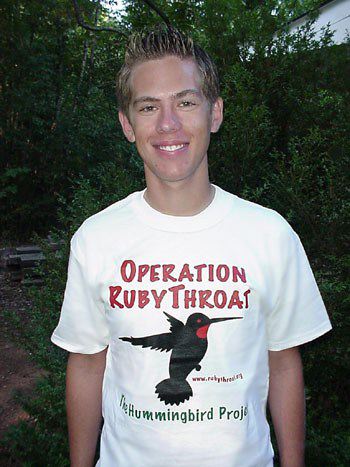
Need a Special Gift just in time for the Holidays? (Or maybe you'd like to make a tax-deductible donation during 2007) If so, why not use our new handy-dandy on-line Google Checkout below to place your secure credit card order or become a Major Donor today? |
|
|
|
|
SPECIES BANDED THIS WEEK: * = New species for 2008 WEEKLY BANDING TOTAL 6 species 24 individuals YEARLY BANDING TOTAL (2008) 6 species 24 individuals 27-YEAR BANDING GRAND TOTAL (since 28 June 1982) 124 species 50,191 individuals NOTABLE RECAPTURES THIS WEEK (with original banding date, sex, and current age) American Goldfinch (1) 02/28/05--5th year female Dark-eyed Junco (1) White-throated Sparrow (2) House Finch (1) Mourning Dove (1)
|
OTHER NATURE NOTES OF INTEREST --We've also been entertained this week by a small raft of Hooded Mergansers patrolling what waters are left in Hilton Pond. Most days three drakes have been doing their best to attract the attention of a lone female, flashing their bright white head patches that gleam conspicuously against a dark pond surface.
|
|
|
|
(Back to Preceding Week; on to Next Week) Up to Top of Page Back to This Week at Hilton Pond Center Current Weather Conditions at Hilton Pond Center |
 You can also post questions for The Piedmont Naturalist |
Join the |
Search Engine for |
|
|
bungee jumping

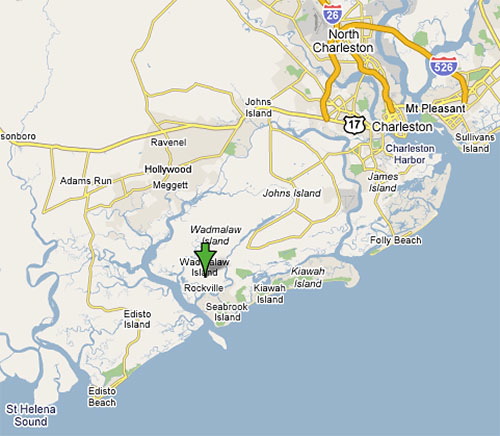
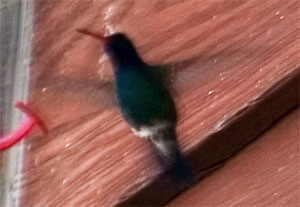 After consulting photos on our Web site for Operation RubyThroat: The Hummingbird Project (
After consulting photos on our Web site for Operation RubyThroat: The Hummingbird Project (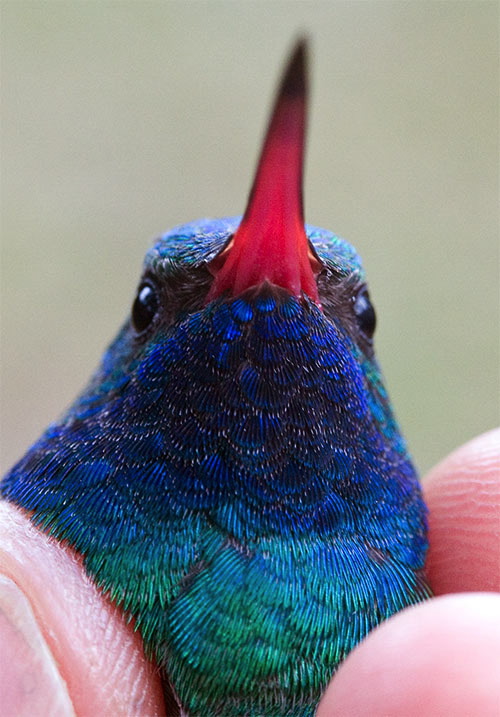
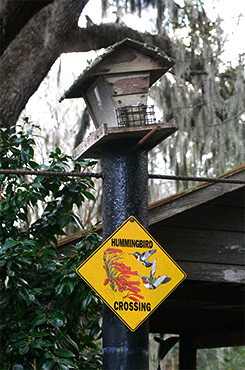 Annabeth remarked she had been hearing this call coming from a big Southern Magnolia tree since at least mid-December but hadn't put two and two together until Donald spotted the blue-throated hummer on 4 January. Annabeth doesn't consider herself an expert birder, but we were impressed with her keen ear, her knowledge of many species on the Proctors' oak-shaded, Spanish Moss-festooned property, that she has fed hummingbirds for perhaps two decades, and that she has been maintaining winter hummer feeders for at least the past 15 years. (We should mention Donald himself was a pretty sharp observer.)
Annabeth remarked she had been hearing this call coming from a big Southern Magnolia tree since at least mid-December but hadn't put two and two together until Donald spotted the blue-throated hummer on 4 January. Annabeth doesn't consider herself an expert birder, but we were impressed with her keen ear, her knowledge of many species on the Proctors' oak-shaded, Spanish Moss-festooned property, that she has fed hummingbirds for perhaps two decades, and that she has been maintaining winter hummer feeders for at least the past 15 years. (We should mention Donald himself was a pretty sharp observer.)
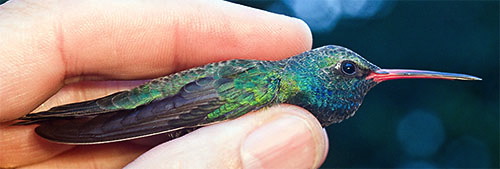
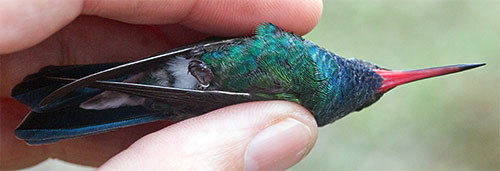
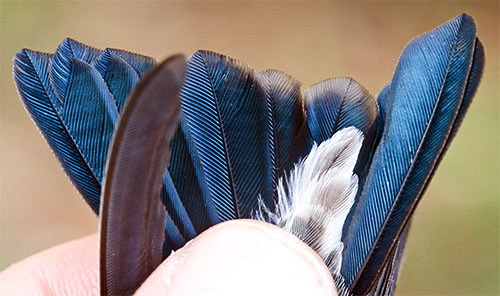
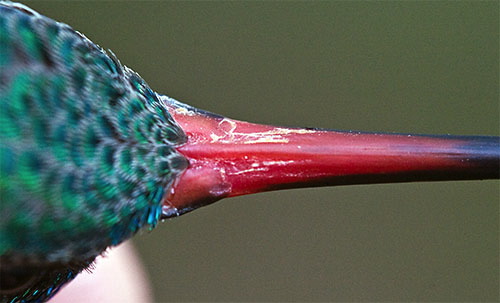
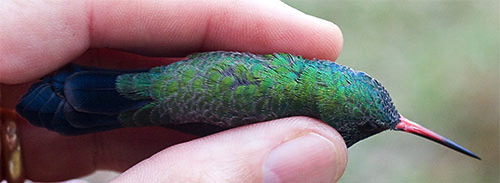
 In an adult male Ruby-throated Hummingbird this distance is typically 37-39mm; in the broad-billed it was a whopping 50.99mm!
In an adult male Ruby-throated Hummingbird this distance is typically 37-39mm; in the broad-billed it was a whopping 50.99mm!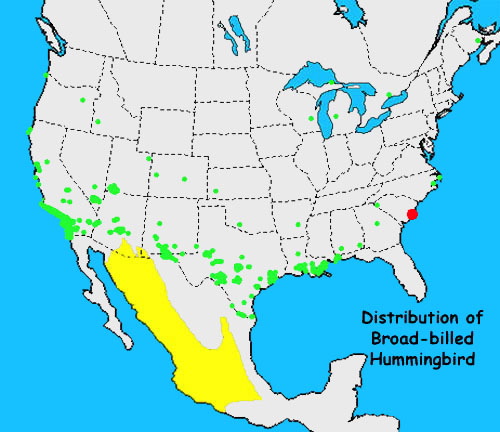
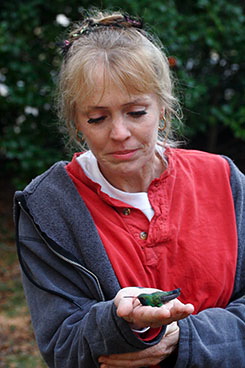 However, since we haven't handled other broad-billeds--particularly in mid-winter--we'll take the conservative approach and simply call the bird an "after-hatch-year."
However, since we haven't handled other broad-billeds--particularly in mid-winter--we'll take the conservative approach and simply call the bird an "after-hatch-year."

 Oct 15 to Mar 15:
Oct 15 to Mar 15: